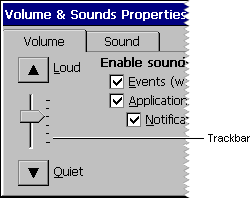
A trackbar, also known as a slider control, is a common control that consists of a bar with tick marks on it and a slider, also known as a thumb. When a user drags the slider or clicks on either side of it, the slider moves in the appropriate direction, in one-tick increments. The following screen shot shows a Windows CE trackbar.

 To create a trackbar
To create a trackbarThis class is registered when the common control DLL is loaded. You can use the InitCommonControls function to ensure that this DLL is loaded. To register the trackbar class using the InitCommonControlsEx function, specify the ICC_BAR_CLASSES flag as the dwICC member of the INITCOMMONCONTROLSEX structure you pass in the lpInitCtrls parameter.
For a complete listing of supported styles, see Window and Control Styles.
You can send messages to the trackbar to retrieve data about the window and to change its characteristics.
To retrieve the slider position, which is the value that a user has chosen, use the TBM_GETPOS message. To set the position of the slider, use the TBM_SETPOS message.
The range of a trackbar is the set of contiguous values that the trackbar can represent. Use the TBM_SETRANGE message to set the range of a trackbar when it is first created. You can dynamically alter the range by using the TBM_SETRANGEMAX and TBM_SETRANGEMIN messages. An application that accepts dynamic range changes retrieves the final range settings when a user has finished working with the trackbar. To retrieve these settings, use the TBM_GETRANGEMAX and TBM_GETRANGEMIN messages.
A trackbar automatically displays tick marks at each end, unless you specify the TBS_NOTICKS style. Use the TBS_AUTOTICKS style to automatically display additional tick marks at regular intervals along the trackbar. By default, a TBS_AUTOTICKS trackbar displays a tick mark at each increment of the trackbar's range. To specify a different interval for the automatic tick marks, send the TBM_SETTICFREQ message to the trackbar.
To set the position of a single tick mark, send the TBM_SETTIC message. A trackbar maintains an array of DWORD values that stores the position of each tick mark. The array does not include the first and last tick marks that the trackbar creates automatically. You can specify an index in this array when you send the TBM_GETTIC message to get the position of the corresponding tick mark. Alternatively, you can send the TBM_GETPTICS message to get a pointer to the array. To retrieve the physical position of a tick mark, send the TBM_GETTICPOS message. The TBM_CLEARTICS message removes all but the first and last of a trackbar's tick marks.
The trackbar line size determines how far the slider moves in response to keyboard input from the arrow keys, such as the RIGHT ARROW or DOWN ARROW key. To retrieve or set the line size, send the TBM_GETLINESIZE and TBM_SETLINESIZE messages, respectively.
The trackbar page size determines how far the slider moves in response to keyboard input, such as the PAGE UP or PAGE DOWN key, or mouse input, such as clicks in the trackbar channel. To retrieve or set the page size, send the TBM_GETPAGESIZE and TBM_SETPAGESIZE messages.
An application can send messages to retrieve the dimensions of a trackbar. The TBM_GETTHUMBRECT message retrieves the bounding rectangle for the slider. The TBM_GETTHUMBLENGTH message retrieves the length of the slider. The TBM_GETCHANNELRECT message retrieves the bounding rectangle for the trackbar channel; the area over which the slider moves. If a trackbar has the TBS_FIXEDLENGTH style, you can send the TBM_SETTHUMBLENGTH message to change the length of the slider.
A trackbar with the TBS_ENABLESELRANGE style can indicate a selection range by highlighting a range of the trackbar channel and displaying triangular tick marks at the start and end of the selection. When a trackbar has this style, you can send messages to set and retrieve the selection range. Typically, an application handles the trackbar notification messages and sets the trackbar's selection range according to user input. The TBM_SETSEL message sets the starting and ending positions of a selection. To set just the starting position or just the ending position of a selection, use the TBM_SETSELSTART or TBM_SETSELEND message. To retrieve the starting and ending positions of a selection range, send the TBM_GETSELSTART and TBM_GETSELEND messages. To clear a selection range, send the TBM_CLEARSEL message.